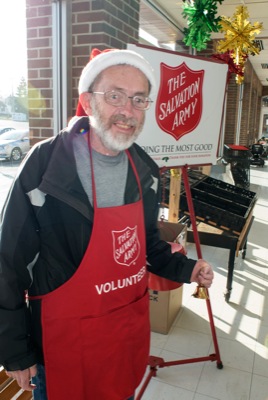Thursday, December 18th, 2014
Hospital prepared to care for Ebola patients
By William Kincaid

Photo by William Kincaid/The Daily Standard
Mercer Health official Nicole Pleiman, left, on Wednesday describes to Celina Rotary Club members the components of a protective suit, modeled by Jenny Conn, to be worn when caring for an Ebola patient. The suit includes a level 4 gown, the most protective gown typically worn by surgeons, boots, two pairs of gloves, an apron and a double-layered hood.
CELINA - Mercer Health hospital officials are confident they can provide care for potential Ebola patients while protecting doctors, staff and others from contamination of the deadly disease that surfaced in the United States for the first time this summer.
Nicole Pleiman, an infection prevention nurse, and Jenny Conn, director of emergency services and coordinator of disaster preparedness, this week told Celina Rotary Club members about Mercer Health's ability to care for Ebola patients if the need arises.
"Jenny and I have worked very, very hard and put in multiple hours to make sure that we can ensure the safety of our staff as well as other patients and visitors in the facility, and we do feel confident that we can care for that patient until we get the Ebola test results back," Pleiman said.
No cases of Ebola have been confirmed in the state of Ohio.
Hospital staff, according to Pleiman, have received a wealth of information about the disease through in-service and training drills.
"Most recently, the beginning of last week, we did a community-wide drill where we actually took a patient by rescue squad to the hospital and worked through the entire process," she said. "That way we could make sure that the community was ready as well, and to see if there were any gaps that we needed to fix."
If a patient exhibited symptoms of Ebola and had recently traveled to West Africa or had contact with someone with the disease, the local hospital would enact a plan to provide immediate care of the patient and protect staff, Pleiman said.
The hospital's emergency department is staffed by 15 healthcare workers trained in treating potential Ebola patients, she said.
"We have a room in our emergency room that's equipped appropriately to maintain these patients until we would find out whether the person actually has Ebola or not," she said.
If confirmed with the illness, the patient would be transported to one of 35 U.S. Ebola treatment centers. Ohio does not have a treatment center but can test for the disease.
"Our plan is to be able to maintain the patient until the testing is complete from the Ohio Department of Health," Pleiman said.
There are no FDA-approved treatments for Ebola. However, staff would provide supportive care to the patient, such as ensuring nutritional support, maintaing blood pressure, treating infections and providing pain medication, according to Pleiman.
"Our plan is to have two nurses taking care of the patient at a time, and we would have one nurse in the room and then a nurse outside of the room that's helping coordinating care from the outside and making sure that the needed supplies are in the room," Pleiman said.
Staff treating potential Ebola patients would wear protective suits, she explained.
"We've trained our staff to safely put on the personal protective equipment and safely remove it, which is a very, very, important piece to caring for any Ebola patient," Pleiman said.
Pleiman explained the protective suit worn by Conn.
"The latest recommendation from the Centers for Disease Control is to make sure that all of your skin is covered," Pleiman said. "She has boots on that go up to her knees and under that we're wearing disposable shoes that can be completely disinfected."
The suit includes a level 4 gown - the most protective type available and typically worn by surgeons.
"And then she has an apron here in hopes that it would collect any extra blood or body fluids, and it's wipeable so you can actually wipe that with disinfectant wipes if you would get contaminated while you're in the room," Pleiman said.
Workers would wear two pairs of gloves - one underneath the gown and one on top - both duct-taped together to prevent separation while tending to a patient, she said.
They also would don a double-layer hood - similar to those used by Hazmat officials - that comes down over the neck, she added.
"With Mercer Health, we're monitoring the situation very closely," Pleiman said. "Jenny and I talk on a daily basis just about the newest information and make sure we are following the latest recommendations from the Centers for Disease Control."
Health departments share an equal role in preventing an Ebola outbreak, they said.
"If we had somebody that we were looking at for Ebola, the health department would actually do all of the investigation and follow-up on the contacts of that person to determine the level of exposure and to determine the needed follow-up," Pleiman said.
Health departments also are responsible for tracking potential Ebola patients in the United States, she said.
"Those people that are coming back (from West Africa) that are at risk for getting Ebola, those health departments are notified that there is someone in their county that is at-risk for that, so it helps with the monitoring process as well," she said.
Depending on a person's exposure, the monitoring process could include quarantine or twice-a-day temperature readings, Pleiman said.
No one from Mercer County has ever been monitored by the health department for Ebola, Pleiman said.
"However, at the hospital we don't get that information because of privacy," she said. "The health department would be the only ones to know about that. We might find out that there's somebody that they're watching in the community but we would have no idea who it is, the sex of the person, the age of the person," Pleiman said.
Ebola was first found in 1976 along the Ebola River in Africa. Sporadic outbursts have occurred since, but nothing of the magnitude recently experienced in West Africa, specifically in the countries of Guinea, Liberia and Sierra Leone, Pleiman said.
"The mortality rate is about 37 percent. It ranges anywhere from around 30 percent to 70 percent with this outbreak," she said.
Mortality rates for past outbreaks have been as high as 90 percent, she said.
"The average time between symptom onset and death is seven days. So typically if you make it past that seven-day mark, that's a really good sign," she said.
Symptoms of Ebola infection include intense weakness, muscle pain, lack of appetite, stomach pain and diarrhea.
"It's typically a very sudden onset of a fever and a headache, almost simultaneously," she said.
Some victims suffer from rash and sore throat; in the most serious cases, the afflicted develop severe infection of the entire body or hemorrhagic symptoms of bleeding both inside and outside the body, leading to organ failure and death.
The recent Ebola outbreak led to 18,000 cases and 6,800 deaths.
"I noticed that the cases are continuing to climb. However, the deaths aren't climbing at quite the rate they were a couple of months ago, so I think that's a good sign," she said.
She attributed the decline in deaths to the World Health Organization's efforts to increase access to health care in Africa.
"The health care systems there were just becoming overwhelmed so they've opened some Ebola hospitals and Ebola treatment centers that I think have helped with things over there," Pleiman said.
New airport screenings also may have helped to reduce the spread of Ebola to the United States, she said.
"I think the airport screenings are really helping and then giving them thermometers and all the instructions on how to check their temperatures," she said. "And I'm hoping that will help us catch anything earlier that would occur before the cases get severe."




